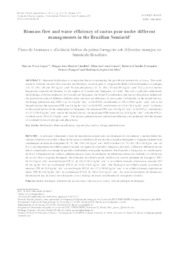Biomass flow and water efficiency of cactus pear under different managements in the Brazilian Semiarid.
Biomass flow and water efficiency of cactus pear under different managements in the Brazilian Semiarid.
Author(s): LOPES, M. N.; CÂNDIDO, M. J. D.; GOMES, E. da C.; POMPEU, R. C. F. F.; SILVA, R. G. da
Summary: Abstract: Balanced fertilization is an important factor in optimizing the growth and productivity of crops. This study aimed to evaluate biomass flow and rain use efficiency in cactus pear cv. Gigante fertilized with combinations of nitrogen (10; 70; 100; 130 and 190 kg ha-1 year-1 N) and phosphorus (10; 70; 100; 130 and 190 kg ha-1 year-1 P2O5), in two harvest frequencies (annual and biennal), in the regions of Quixadá and Tejuçuoca, in Ceará. This was a split-plot randomized block design, with four replicates. In Quixadá and Tejuçuoca, the N and P combinations and harvest frequencies influenced the productions rates of different cladode orders and rain use efficiency in cactus pear. In Quixadá, in the annual harvest, the forage production rate (FPR) was 10.3 kg ha-1 day-1 in the N/P2O5 combination at 190.0/190.0 kg ha-1 year-1 and in the biennal harvest, the maximum FPR was 4.6 kg ha-1 day-1 in the N/P2O5 combination at 114.6/136.8 kg ha-1 year-1. In relation to the annual harvest in the municipality of Tejuçuoca, the maximum FPR was 30.0 kg ha-1 day-1 in the N/P2O5 combination at 137.5/190.0 kg ha-1 year-1 and in the biennal harvest, the maximum FPR observed was 38.0 kg ha-1 day-1 with the N/P2O5 combination of 190.0/33.4 kg ha-1 year-1. The biomass productions rate and rain use efficiency are optimized with the balance of combined levels of nitrogen and phosphorus. [Fluxo de biomassa e eficiência hídrica da palma forrageira sob diferentes manejos no Semiárido Brasileiro]. Resumo: A adubação balanceada é fator de importância comprovada na otimização do crescimento e produtividade das culturas. Objetivou-se avaliar o fluxo de biomassa e a eficiência de uso da chuva na palma forrageira cv. Gigante, adubada com combinações de doses de nitrogênio (10; 70; 100; 130 e 190 kg ha-1 ano-1 de N) e fósforo (10; 70; 100; 130 e 190 kg ha-1 ano-1 de P2O5), nas frequências de colheita anual e bianual, nas regiões de Quixadá e Tejuçuoca, no Ceará. Utilizou-se delineamento em blocos casualizados, em arranjo de parcelas subdivididas, com quatro repetições. Em Quixadá e Tejuçuoca, as combinações de N e P e frequências de colheita influenciaram as taxas de produções de diferentes ordens de cladódios e a eficiência de uso da chuva na palma forrageira. Em Quixadá, na colheita anual, verificou-se taxa de produção de forragem (TPF) de 10,3 kg ha-1 dia-1 na combinação N/P2O5 de 190,0/190,0 kg ha-1 ano-1 e na colheita bianual, observou-se máxima TPF de 4,6 kg ha-1 dia-1 na combinação N/P2O5 de 114,6/136,8 kg ha-1 ano-1. Em Tejuçuoca, na colheita anual, constatou-se máxima TPF de 30,0 kg ha-1 dia-1 na combinação N/P2O5 de 137,5/190,0 kg ha-1 ano-1 e na colheita bianual, registrou-se maior TPF de 38,0 kg ha-1 dia-1 na combinação N/P2O5 de 190,0/33,4 kg ha-1 ano-1. As taxas de produções de biomassa e eficiência de uso da chuva são otimizadas com o balanço de doses combinadas de nitrogênio e fósforo
Publication year: 2018
Types of publication: Journal article
Unit: Embrapa Goats & Sheep
Observation
Some of Embrapa's publications are published as ePub files. To read them, use or download one of the following free software options to your computer or mobile device. Android: Google Play Books; IOS: iBooks; Windows and Linux: Calibre.
Access other publications
Access the Agricultural Research Database (BDPA) to consult Embrapa's full library collection and records.
Visit Embrapa Bookstore to purchase books and other publications sold by Embrapa.

